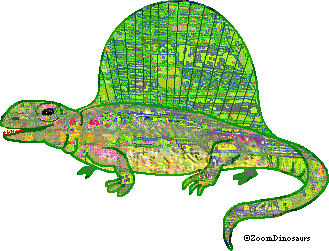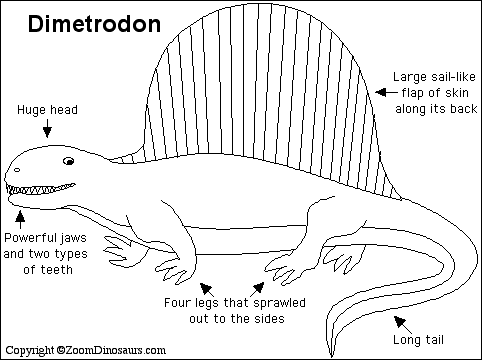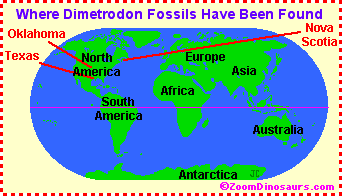Advertisement.
EnchantedLearning.com is a user-supported site.
As a bonus, site members have access to a banner-ad-free version of the site, with print-friendly pages.
Click here to learn more.
(Already a member? Click here.)
Click on an underlined word for more information on that subject.
If the dinosaur or paleontology term you are looking for is not in the dictionary, please e-mail us.
 |
DIMETRODON grandis, Meaning "Two-measures Tooth"
- Not a dinosaur, but a pelycosaur!
- A carnivore
- Lived during the Permian period (280-245 million years ago)
- Had a spiny sail along its back
- Walked on four, side-sprawling legs
|
Dimetrodon was a sail-backed, meat-eating animal that lived during the Permian Period, roughly 280 million year ago, long before the dinosaurs evolved. It was a so-called mammal-like reptile, an ancestor of the mammals.
ANATOMY
Dimetrodon was about 11.5 feet (3.5 m) long and weighed roughly 550 pounds (250 kg). It had a large sail-like flap of skin along its back, dense with blood vessels. The sail was supported by long, bony spines, each of which grew out of a separate spinal vertebra (a bone in the back). The sail may have been a thermoregulatory structure, used to absorb and release heat. The sail may have also been used for mating and dominance rituals, and/or for making it look much larger than it was to predators. Dimetrodon had sharp teeth and clawed feet.

ECOLOGY
Dimetrodon was a dominant carnivore during the Permian period, living mainly in swampy areas. Unlike their fellow non-finned pelycosaurs, they warmed up early after sunrise, and cooled off more efficiently during the heat of the day. This efficient thermoregulation along with their large and powerful jaws gave them the advantage over their cohorts, making them dominant.
LOCOMOTION
Dimetrodon walked on four legs that sprawled out to the sides (unlike the dinosaurs, whose legs extended under their bodies). It was probably a very fast runner.
CLASSIFICATION
The Dimetrodon is not a dinosaur, and is probably more closely related to us
than to the dinosaurs. It is a pelycosaur, which had many mammal-like characteristics and is among the relatives of warm-blooded mammals. Dimetrodon' classification follows:
- Kingdom Animalia (animals)
- Phylum Chordata (chordates)
- Subphylum Vertebrata (vertebrates)
- Superclass Tetrapoda (tetrapods - having four legs)
- Class Synapsida (synapsids) - these include the mammals, sphecodonts, basal therapsids, caseasaurs, and pelycosaurs. They are distinguished by having a skull with a low opening behind their eyes, whose only non-extinct members are the mammals.
- Order Pelycosauria (pelycosaurs) - the earliest synapsids which evolved during the Carboniferous period, 300 million years ago. These included Archaeothyris, Ophiacodon, Varanosaurus, Casea, and Edaphosaurus.
- Family Sphenacodontidae (sail-finned pelycosaurs, Dimetrodon, Sphenacodon, Ctenospondylus, and Secodontosaurus)
- Genus Dimetrodon
- Many species - the largest is D. angelensis
WHEN DIMETRODON LIVED
Dimetrodon appeared in the late Paleozoic Era, during the Permian period (about 280 million year ago), long before the dinosaurs evolved. Dimetrodon went extinct in the huge Permian extinction, 245 million years ago, which immediately preceded the Mesozoic Era.
BEHAVIOR
Dimetrodon probably sunned itself every day to raise its temperature and leave its cold, sluggish, night-time state. Its sail sped up this process enormously. It has been calculated that an average adult dimetrodon (weighing about 440 pounds = 200 kg) would take about 1 1/2 hours to raise its temperature from 79°C to 90°C (26°C to 32°C).
DIET
Dimetrodon was a carnivore with a huge head and mouth, large, powerful jaws, and two types of teeth - sharp canines and shearing teeth. It probably ate other pelycosaurs (its close relatives), insects, and other animals. It could leave its cold, sluggish state much earlier after sunrise than the pelycosaurs with no sails (such as Archaeothyris, Casea, Ophiacodon, and Varanosaurus) and catch and eat them.
DISCOVERY AND NAMING OF FOSSILS
 Fossils of Dimetrodon have been found in Texas and Oklahoma in the USA. Trackways (fossilized footprints) of Dimetrodon have been found in Nova Scotia, Canada. Dimetrodon was named by paleontologist Edward Drinker Cope.
Fossils of Dimetrodon have been found in Texas and Oklahoma in the USA. Trackways (fossilized footprints) of Dimetrodon have been found in Nova Scotia, Canada. Dimetrodon was named by paleontologist Edward Drinker Cope.
DIMETRODON ACTIVITIES
DIMETRODON WEB LINKS
Dimetrodon from the American Museum of Natural History
Dimetrodon from the Carnegie Museum of Natural History.
 Information Sheets About Dinosaurs Information Sheets About Dinosaurs
(and Other Prehistoric Creatures) |
Just click on an animal's name to go to that information sheet. If the dinosaur you're interested in isn't here, check the Dinosaur Dictionary or the list of Dinosaur Genera. Names with an asterisk (*) were not dinosaurs.
How to write a great dinosaur report.
For dinosaur printouts, click here.For brief dinosaur fact sheets, click here.
Enchanted Learning®
Over 35,000 Web Pages
Sample Pages for Prospective Subscribers, or click below
Click to read our Privacy Policy
Enchanted Learning Search
|
Search the Enchanted Learning website for:
|
Advertisement.
Advertisement.
Copyright ©1997-2018
EnchantedLearning.com ------ How to cite a web page


Fossils of Dimetrodon have been found in Texas and Oklahoma in the USA. Trackways (fossilized footprints) of Dimetrodon have been found in Nova Scotia, Canada. Dimetrodon was named by paleontologist Edward Drinker Cope.
